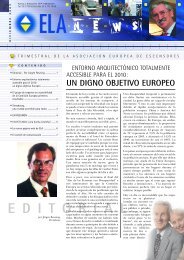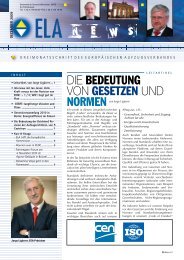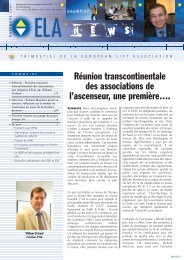WP6-Brochure-E4 brochure - ELA European Lift Association.
WP6-Brochure-E4 brochure - ELA European Lift Association.
WP6-Brochure-E4 brochure - ELA European Lift Association.
Create successful ePaper yourself
Turn your PDF publications into a flip-book with our unique Google optimized e-Paper software.
6.2. Electricity consumption of lifts in Europe<br />
According to the characterisation of the lifts’ installed base conducted as part of Work Package<br />
2 of the <strong>E4</strong> project, there are around 4.5 million lifts installed in the 19 countries surveyed.<br />
The data obtained with the survey of the WP2, related to 19 countries, were adjusted to EU‐<br />
27, plus Switzerland and Norway. Using the methodology previously described the total<br />
electricity consumed by lifts is estimated to be 18,4 TWh, of which 6,7 TWh are in the<br />
residential sector, 10,9 TWh in the tertiary sector and only 810 GWh in the industrial sector.<br />
Figure 6‐1 shows the running and standby estimated annual energy consumption of <strong>European</strong><br />
lifts in the residential and tertiary sector. Although the number of lifts installed in the tertiary<br />
sector is smaller, their energy consumption is far bigger than the one in the residential sector<br />
due to their more intensive use.<br />
Table 6‐3. Number of lifts installed (EU‐27)<br />
Hydraulic Geared Gearless Total<br />
Traction Traction<br />
Residential 743.979 2.254.112 100.330 3.098.421<br />
Tertiary 333.248 946.208 270.344 1.549.801<br />
Industrial 49.312 126.397 227 175.936<br />
Total 1.126.539 3.326.718 370.901 4.824.157<br />
12.000<br />
10.000<br />
8.000<br />
GWh<br />
6.000<br />
4.000<br />
2.000<br />
Standby<br />
Running<br />
0<br />
Residential<br />
Tertiary<br />
Figure 6‐1. <strong>Lift</strong> annual electricity consumption<br />
As it can be seen, the standby energy consumption represents an important share of the<br />
overall energy consumption, especially in lifts installed in the residential sector, where the<br />
time spent in standby mode is longer. The next figure presents the standby consumption and<br />
the running mode consumption, in proportion to the overall consumption in the residential<br />
and the tertiary sectors.<br />
81

















